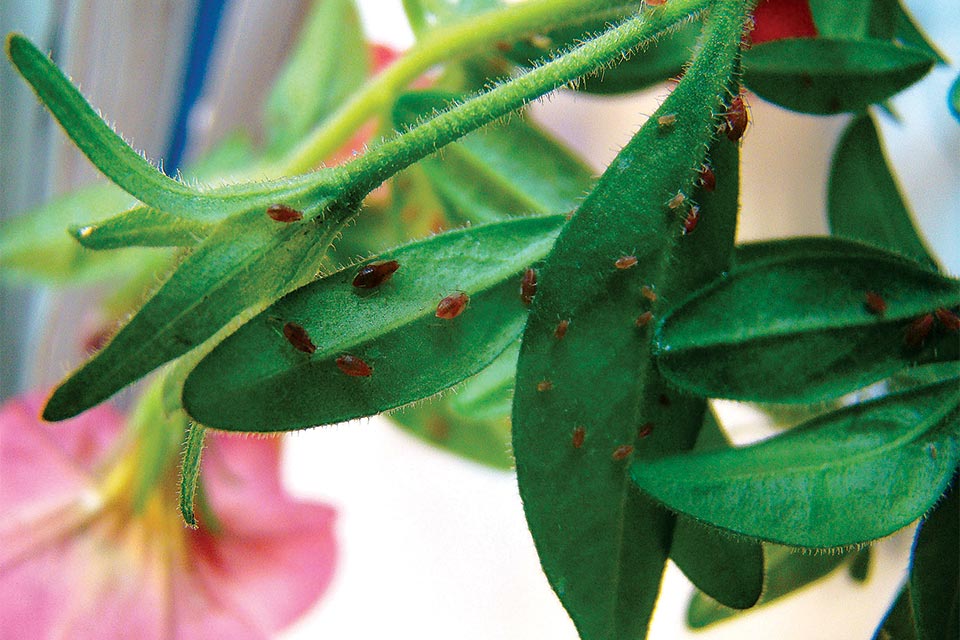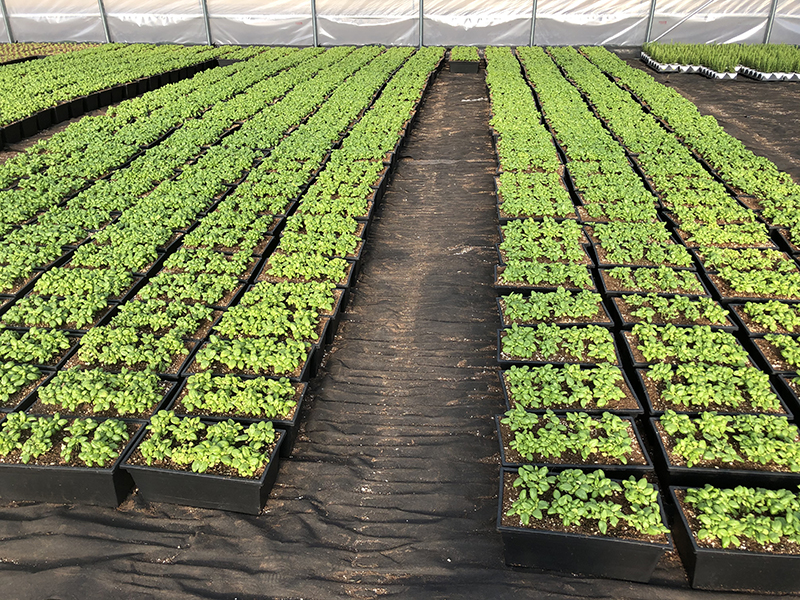How To Stop Aphids In The Greenhouse

Aphids often accumulate on the soft shoot tips, flower stems, and the underside of young leaves, like this small colony on calibrachoa.
Aphids present the perfect storm as a greenhouse pest. They bring a very high reproductive rate, a preference for popular spring crops, negative and visible impacts on plant health, low customer tolerance, and emerging pesticide resistance. An added predicament: Some growers face pressure to avoid use of an effective tool, the neonicotinoids. Amidst these barriers and obstacles, what’s a grower to do? Here are a few ideas to help you gain the upper hand on this prolific little beast.
Aphid Biology 101
Let’s start with a quick review of aphid biology. Aphids feed by sucking plant juices from soft tissues. They prefer growing tips, but can also be found along stems or covering lower-leaf surfaces. Aphids can even attack plant roots. Reproduction is generally asexual. This means the offspring share nearly identical genes, which allows for resistance to develop quickly. An aphid that escapes treatment will pass those advantageous, resistant gene(s) to all of her offspring. Aphids pack another reproductive punch: They give birth to live young carrying developing nymphs. It’s no wonder that the population can seem to explode overnight.
Aphid size and color vary across and within species, with several different species common in greenhouses, including green peach, cotton/melon, foxglove, and potato aphids. However, aphids as a group are relatively easy to identify by the unique cornicles (tubes that project from the abdomen) at the rear of their bodies. Aphid nymphs are simply small versions of the adults, and most aphids are wingless. Winged forms develop when dispersal is needed to support an expanding aphid colony’s need for food. If you see winged aphids, the outbreak is ahead of your pest control measures and/or your scouting has failed.
Scout Routinely To Catch Problems Early
Frequent and regular scouting is important because populations build quickly. Sometimes signs are quite visible: The aphids are seen, distortion exists, or white cast-skins accumulate. Aphids repeatedly shed their exoskeletons; the cast-skins can be seen clinging to leaves near or below the colony, decreasing plants’ salability. Aphids also excrete copious amounts of shiny, sticky honeydew. Honeydew then supports growth of an unsightly, but non-pathogenic, black fungus called sooty mold.
Beat tests will reveal aphid colonies hidden in the foliage. To conduct a beat test, hold white paper under the plant and gently shake or tap the foliage to dislodge pests and cast-skins. Sticky cards will capture the winged aphids, whose presence should always send you searching for the exploding colony. Scout historic hot spots and aphid-favored crops carefully for early problems (e.g., petunia, calibrachoa, gerbera, pepper). Also, train staff to isolate and inspect incoming material and encourage sharp eyes on the transplant line.
Integrated Pest Management Is The Best Plan Of Attack
GGSPro promotes an integrated approach to pest control. This starts with culture. Aphids can be discouraged by avoiding soft, lush growth. Be especially sure to avoid luxury nitrogen levels. When released early and properly, biological control agents (BCAs) can be effective. Parasitoid wasps (Aphidius spp.), predatory midges (Aphidoletes aphidimyza), and lacewing larvae (Chrysoperla carnea) work well in managing aphids. Aphidius species selection is based on aphid species and season, and other release details favor success in BCA use. Contact your supplier to learn more.
Several factors influence chemistry choices for aphid control. Options are restricted for edibles, making BCAs especially helpful. Some drench products offering longevity in the plant, such as Flagship, Marathon, and Safari, remain strong and effective options for control. However, you need to plan their use carefully, since they present a bee hazard when used improperly. For growers facing restrictions on neonic use, turn to Kontos or Mainspring for drench options. For growers not facing customer-driven restrictions on neonic use, bee risk can be avoided by timing application so that the interval for bee risk expires before bees have access to the flowers. Pay special attention to plants that provide preferred forage to bees, specifically perennial members of the Compositae family.
Keep an eye out for research reporting bee forage preference, as this is an active area of research. David Smitley (Michigan State University) recently reported that none of our 25 top-selling annual crops are highly attractive to honeybees. As this type of information accumulates, growers can make more educated choices.
Lastly, we’re starting to see resistance develop for a few products, reinforcing the need to plan strong rotation across modes of action (MOA). Here’s a list of products that have been effective. Remember to always read and follow the product label, especially when it comes to treating edibles.
Drench Applications (MOA is shown in parentheses.)
Discus N/G (3A & 4A) – May also be used as a spray. Four or more weeks of control.
Flagship (4A) – May also be used as a spray. Label allows a spray for some vegetable transplants (no drench on edibles). Four or more weeks of control.
Kontos (23) – Spray or drench, including some vegetable transplants. Allow two to three weeks for activity. Up to six weeks of control from drench. Read label for crop sensitivities, including geraniums, spikes, and cordyline.
Mainspring (28) – Most effective by drench. Up to six weeks of control.
Marathon/Mantra/Mallet/Benefit (4A) – Also can use as a spray. Up to four weeks of control. Use as spray for some vegetable transplants (no drench on edibles).
Safari (4A) – Drench. Very quick uptake (24 hours) with quick knockdown. Four or more weeks of control.
Spray Applications
Aria (9C) – Feeding blocker. Translaminar. Four-week residual.
Endeavor (9B) – Feeding blocker. Good bloom safety. Up to three-week residual.
Enstar AQ (7A) – Insect growth regulator interrupts life cycle and prevents maturation. May burn some blooms.
Fulfill (9B) – Feeding blocker. Label includes many edibles; sub Endeavor for ornamentals. Up to three-week residual.
M-Pede (UN) – Contact control only. May burn blooms or tender growth. Often mixed with Azatin O, Azaguard, or Molt-X for best control. OMRI (Organic Materials Review Institute)-listed.
Rycar (UN) – Contact and translaminar. Expectation for good bloom/plant safety.
TriStar (4A) – Contact and translaminar. Good bloom/plant safety.
Microbial Insecticides
Fungal- or bacterial-based products offering soft-control options. Effective following multiple applications and slower than traditional chemistries.
Botanigard 22WP/Botanigard ES/Mycotrol ESO/Mycotrol WPO (UN) – Label includes many edibles. Requires three spray applications at three- to five-day intervals. Best tank-mixed with Azatin 0, Azaguard, or Molt-X.
Botanigard WP offers greater plant and biological control agent (BCA) safety compared to the ES formulation. Mycotrol ESO and Mycotrol WPO are OMRI-listed.
Grandevo PTO (UN) – Label includes many edibles. Weekly spray applications at first sign of aphids, continue for three weeks. OMRI-listed.
Preferal (UN) – Label includes many edibles. Drench or spray. Best spray performance under extended high humidity. OMRI-listed.
The pesticide information presented in this article is believed to be correct at the time of publication. However, it’s the responsibility of the applicator to read and follow all label instructions. Labels do change without notice. Not all products mentioned are registered for use in all states. Some products are restricted in some states and not in others. Products other than those mentioned here may also be safe and effective.









